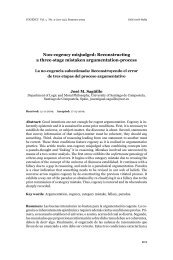Cogency v2 n2
Cogency v2 n2
Cogency v2 n2
Create successful ePaper yourself
Turn your PDF publications into a flip-book with our unique Google optimized e-Paper software.
COGENCY Vol. 2, N0. 2, Spring 2010<br />
–And now at some point he continues the series independently–or he<br />
does not.–But why do you say that? so much is obvious!–Of course; I<br />
only wished to say: the effect of any further explanation depends on his<br />
reaction. (§145)<br />
We can imagine Wittgenstein putting on a funny hat in order to speak to<br />
himself in this way, or we can imagine that there are several voices, or we<br />
can accept the voicing as irreducibly ambiguous.<br />
The ambiguity seems deliberate because there are also passages in the<br />
Investigations where Wittgenstein uses quotation marks carefully and clearly<br />
to mark a second voice, as in §186 and subsequent passages: in that passage,<br />
the interlocutor says “What you are saying then, comes to this: a new<br />
insight–intuition–is needed at every step…” There are parts of the text where<br />
the voicing is unequivocal, as well as places where things are blurred. In the<br />
Blue Book and Brown Book, by contrast, there does not appear to be any of<br />
this blurring. In the internal dialogues in the earlier texts, it is never that<br />
unclear who is speaking. It is either Wittgenstein or a challenger, and if it is<br />
a challenger, the challenge is in quotation marks. Wittgenstein also challenges<br />
himself in his own voice, but when he does so he explicitly introduces<br />
the challenge with a phrase like “Now one may be tempted to say…” (Blue<br />
Book 22) or even with both explicit framing in addition to quotation marks,<br />
e.g., “you may be inclined to say, “But why…’” (Brown Book 17).<br />
We have mentioned one reason why Wittgenstein blurs the speakers’<br />
identities in Investigations – because it is easier for the reader to take ownership<br />
of ambiguously voiced questions. This would be useful in many contexts,<br />
but it is especially important in the context of Wittgenstein’s project<br />
and absolutely crucial for Wittgenstein’s target audience: philosophers.<br />
Philosophers who read the Investigations can hardly resist trying to discern<br />
Wittgenstein’s own position on what they take to be the key issues, like<br />
the nature of linguistic meaning, puzzles about reference, the metaphysical<br />
status of propositions, what truth is, and so on. Those sections of the text<br />
with discussions bearing on these issues will prompt philosophical readers<br />
to extract a theory that can then be attributed to Wittgenstein. Theorists<br />
will then seek – and, therefore, find – arguments in support of their favored<br />
interpretations. This is an effective interpretive approach for many texts.<br />
36








